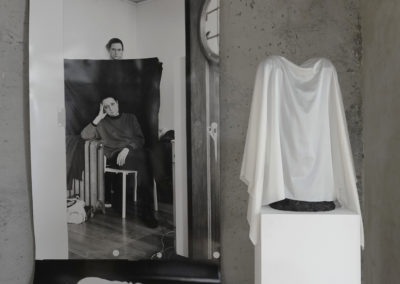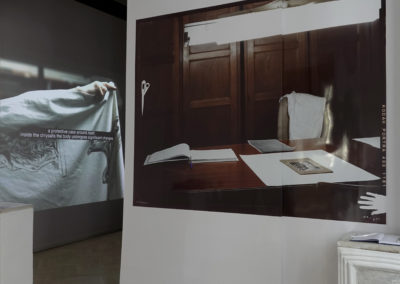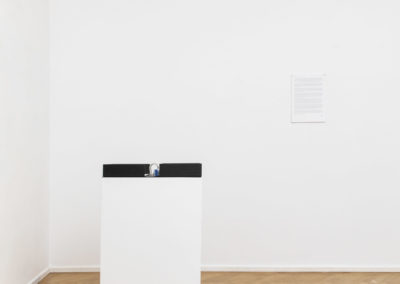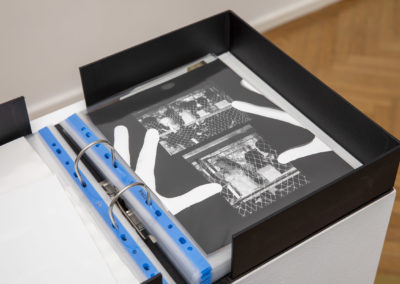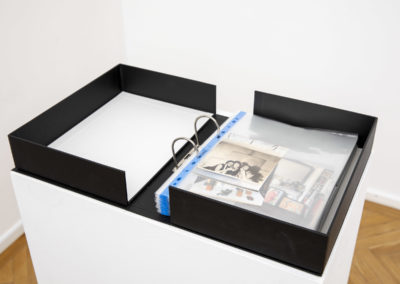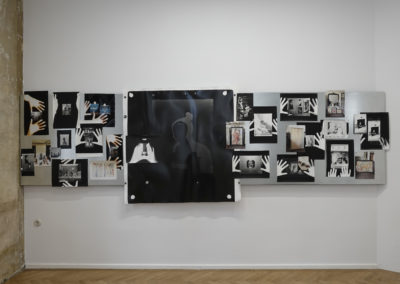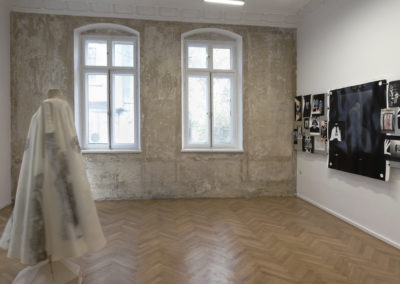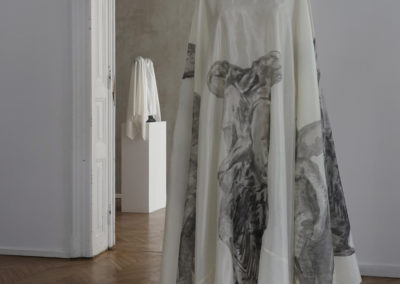Back Stages unthreads the legacy of the artist Irène Codreano (1896-1985), navigating through the traces of ‘herstory’, to reflect how art exists in an embedded relation to the systems that surround it. Moving across the halls of museums, the corridors of archives, the silent shelves of libraries, as well as the former artist studios in Bucharest and Paris, Mirela Baciak, Sophie Thun, and Aurora Király engaged in this trans-contextual research project to seek kinship across time.
The exhibition is a deeply collaborative and somewhat speculative endeavor to forge a connection with Irène Codréano, whilst casting a contemplative glance at the institutional spaces where art is archived, stored or displayed, and explore the nuanced nexus between the acts of access, protection, and care.
The collaboration with MNAR – the National Art Museum of Romania, home to an invaluable collection of Codréano’s sculptures, the research trip to Paris to visit the Brancusi Archives at Bibliotheque Kandinsky in Centre Pompidou and documentation at the Barbu Brezianu Archives at the Institute of Art History “G. Oprescu” in Bucharest were invaluable to the development of the project.
Back Stages
Artists: Aurora Király,Sophie Thun and Irène Codreano (†)
Curated by Mirela Baciak
27.10.2023-13.01.2024
ARAC, 26 Popa Soare Street, Bucharest
In the grand tapestry of avant-garde milieu in Paris, Codreano’s tale occupies a delicate, almost invisible thread. Although nestled within the heart of the Parisian artistic scene of the 1920ties, and having crossed paths with renowned figures like Alberto Giacometti, May Ray, or Marcel Duchamp a.o., her narrative remains partly eclipsed by the sands of time. The enigmatic essence of Codreano’s life serves as a reminder of the many untold tales of women artists, whose contributions yet remain to be fully unearthed.
Tne particularly intriguing fact of Codreano’s artistic journey is her education under two markedly distinct sculptors—Antoine Bourdelle, a pupil of Rodin, and Constantin Brancusi, the pioneer of modernist sculpture. This dual mentorship encapsulates a narrative of evolving artistic paradigms, as Codreano traversed from the figurative, classical techniques learned from Bourdelle to the modernist approach of Brancusi. This intertwinement of contrasting styles in Codreano’s education, under the iconic yet differing Bourdelle and Brancusi, defined a crucible in which her practice melded with tradition and modernity.
Ten of the sculptures that Codreano produced during her time in Paris are housed in the collection of MNAR – the National Museum of Art of Romania. Together with Sophie Thun and Aurora Király, we visited the storage of this museum to seek a connection with Codreano through physical interaction with her art. We photographed the ten sculptures, five of which can be seen in the museum’s permanent display of the collection, and five of which are hidden in storage.
While researching the Brancusi Archives at Bibliotheque Kandinsky at the Centre Pompidou, the vast documentation of Brancusi’s life presented us with a fragmented image of Codreano, leaving much of her interactions with Brancusi and other contemporary male artists to speculative whispers. The scant traces of her correspondence, some with renowned artists like Fernand Léger, only provide fleeting glimpses into her professional network.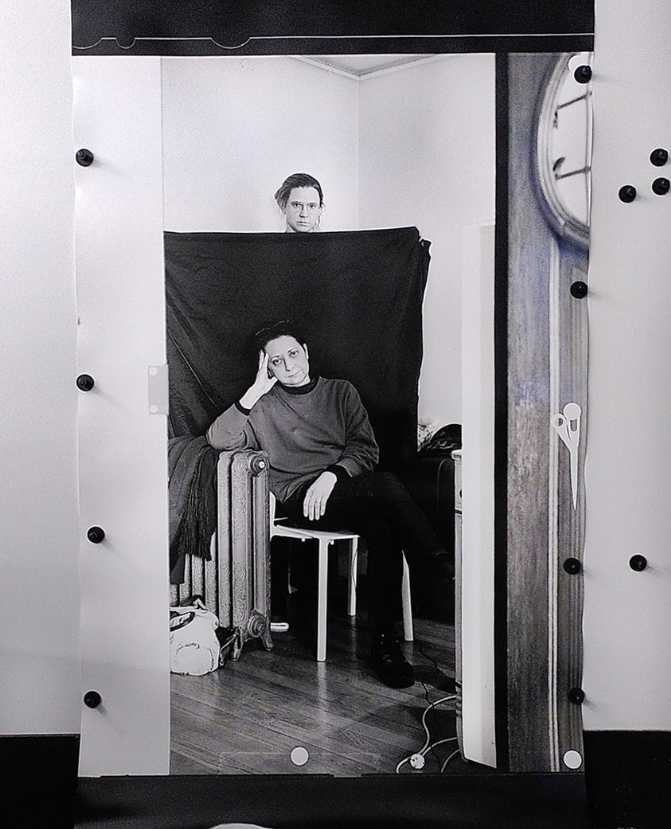
What grasped our attention were Codreano’s drawings and sketches of female figures which we accessed through the digital archive at Bibliotheque Kandinsky, encapsulating a sense of longing and a deep understanding of the feminine form and psyche. Her exploration of the feminine body, coupled with the unique blend of modernist and classical sculpture techniques, symbolizes a resolute venture into a realm that was dominated by male personas. At Bibliotheque Kandinsky, we could also digitally access the photographs presumably taken by Constantin Brancusi at his studio around the year 1922 of Irène, her sister Lizica, and Eileen Lane. These pictures opened for us a window to a realm where the spirit of the avant-garde fluttered, where the three female figures looked like the Three Graces in whom beauty was deified.
Another ephemeral glimpse of Codreano can be seen in a photograph where Duchamp, Man Ray, and a female figure, presumably Codreano, toast to the zeitgeist of an era. This image (housed in the Museum of Philadelphia), which we could equally only see on a digital screen, perhaps epitomizes the enigmatic narrative of Codreano’s life, a life that traversed the alleys of surrealism, the paths of classicism, and the uncharted realms of personal identity.
The undocumented spaces in Codreano’s life grew wider as we moved toward the interwar and post-World War II periods. The glimpses of her life through fleeting eBay sales of personal letters or speculative mentions in archived photographs continue to foster an aura of mystery around her. In the war-torn Europe, Codreano moved to the serene landscapes of southern France. It is not known if she might have been Jewish or not. According to Frédéric Fontenoy, the grandson of Lizica, the Codreano family was orthodox Christian, and the sisters had many Jewish friends.
What one letter from Irène and her sister Lizica to Marcel Mihalovici offered on eBay by aristide1299 expressed a deep concern for the situation of the Jewish composer Mihalovici. In the summer of 1940, while Paris was occupied, with the help of sisters Codreano, Mihalovici, and his wife, the pianist Monique Haas, went into exile in Cannes. At the beginning of the war, Irene also hid the composer Manuel Rosenthal in her studio.
Codreano’s dedicated romantic relationships (she was married to the Reuters reporter Harold King after the war) seem to contrast with her sister Lizica’s, whose love affair with the artist and photographer Hans Bellmer was an open secret, and who was married to the French journalist, writer, communist and later a fascist politician Jean Fontenoy. Lizica followed her husband to Shanghai, where they had a child François, and after a nearly five-year stay there, she returned to Paris with the child in 1931, and divorced Jean Fontenoy in 1936. This hints at an enigmatic divergence of paths the sisters might have taken in their personal lives amidst the whirlpool of artistic and political ideologies swirling around them. Codreano’s return to post-war Paris, her marriage to Harold King, and her subsequent life remain nestled in vague narratives, with fragments of her work serving as the sole beacon illuminating portions of her life. The shift in her stylistic expressions during the ’30s, from avant-garde to classical figures, elucidates the dance between artistic aspiration and economic pragmatism. Amidst all, the thread of economic realities weaving through her narrative, the adaptations in her style during trying times, and her migration to the southern reaches of France during the Second World War, outlines an artist navigating the turbulent waters of personal, artistic, and socio-political realms.
Codreano’s return to Bucharest for a 1937 exhibition and her continued engagement with the Romanian art community remain largely undocumented. The mystery surrounding her life post-Brancusi, and her overall contribution to the modernist sculpture movement embodies the many untold stories lurking within the annals of art history. Through the fragments of Codreano’s life and work, we may catch a glimpse of a narrative yearning for a fuller exploration, promising to enrich our understanding of the intricate tapestry that is the modernist sculpture movement. Her narrative urges a deeper dive into the unexplored archives, beckoning a reevaluation and a broader acknowledgment of the often-overlooked artists nestled within the folds of art history.
In revisiting Codreano’s narrative, we may find the emblematic representation of numerous female artists of the era, whose stories remain overshadowed, their contributions awaiting a thorough examination to be rightfully enshrined within the broader narrative of art history.
– Text by Mirela Baciak
* Note from the author: this text is largely informed by a conversation with the art historian Franck Joubin, which took place on the 20th of March 2023.
The author would like to express a thank you to Frédéric Fontenoy, the grandson of Lizica, for fack-checking this text.
Back Stages is organised by the Romanian Association of Contemporary Art (ARAC) and is a project co-funded by the Administration of the National Cultural Fund, Phileas and the Austrian Cultural Forum. The Back Stages project does not necessarily represent the position of AFCN. AFCN is not responsible for the content of the project or how the results of the project may be used. These are entirely the responsibility of the beneficiary.
Partners: National Art Museum of Romania, Hungarian Liszt Institute Bucharest, Bundesministerium Kunst, Kultur, öffentlicher Dienst und Sport, Culture Moves, Aqua Carpatica, Crama Corcova.
Media partners: Arta magazine
Sponsor: OMV
ARAC is a non-profit organization founded in June 2012, in order to produce and promote contemporary art in Romania and abroad. The initiative of the 58 Plantelor Residency belongs to Anca Poterasu, gallerist and ARAC President. The first edition of the Residency took place in 2015 and it was financed through a grant offered by Norway, Iceland, Liechtenstein and the Romanian Government.

